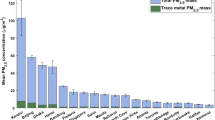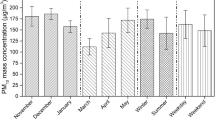Abstract
Introduction
This study collected long-term airborne lead concentrations in the Korean peninsula and analyzed their temporal, spatial, and cancer risk characterization.
Methods
Approximately, 12,000 airborne samples of total suspended particulate (TSP) were collected from 30 ambient air monitoring stations in inland (Daegu, Daejeon, Gwangju, and Seoul) cities and portal cities (Incheon, Busan, and Ulsan) over a period of 7 years (2004–2010). High volume air samplers were employed to collect daily TSP samples during the second week of the consecutive months throughout the entire study period. The concentrations of Pb extracted from the TSP samples were analyzed using either inductively coupled plasma-atomic emission or flame atomic absorption spectrometry.
Results
The long-term high mean Pb concentrations were observed in the port cities including Incheon (88 ± 18 ng/m3), Ulsan (61 ± 7 ng/m3), and Busan (58 ± 6 ng/m3). In the temporal analysis, seasonal mean Pb levels were relatively higher in winter and spring than those in summer and fall. In the spatial analysis, the mean Pb levels in spring, winter, and fall from Incheon, which showed the highest seasonal concentrations except summer, were 110 ± 19, 101 ± 18, and 76 ± 23 ng/m3, respectively. In summer, the highest seasonal mean Pb level was observed in the largest industrial city and the second port city, Ulsan (78 ± 15 ng/m3), followed by Incheon (65 ± 13 ng/m3).
Conclusion
The estimated excess cancer risk analysis showed that inhalation of Pb could result in cancer for one or two persons per million of population in the Korean peninsula.








Similar content being viewed by others
References
Allen AG, Nemitz E, Shi JP, Harrison RM, Greenwood JC (2001) Size distributions of trace metals in atmospheric aerosols in the United Kingdom. Atmos Environ 35:4581–4591
Basha S, Gaur PM, Thorat RB, Trivedi RH, Mukhopadhyay SK, Anand N, Desai SH, Mody KH, Jha B (2007) Heavy metal content of suspended particulate matter at world’s largest ship-breaking yard, Alang-Sosiya, India. Water Air Soil Pollut 178:373–384
Basha S, Jhala J, Thorat R, Goel S, Trivedi R, Shah K, Gopalakrishnan M, Gaur P, Mody KH, Jha B (2010) Assessment of heavy metal content in suspended particulate matter of coastal industrial town, Mithapur, Gujarat,India. Atmos Res 97:257–265
Bhaskar BV, Rajasekhar RVJ, Muthusubramanian P, Kesarkar AP (2010) Ionic and heavy metal composition of respirable particulate in Madurai, India. Environ Monit Assess 164:323–336
Cho SH, Bryant JR, Thornburg J, Portzer J, Vanderpool R, Cavender K, Rice J (2011) A literature review of concentrations and size distributions of ambient airborne Pb-containing particulate matter. Atmos Environ. doi:10.1016/j.atmosenv.2011.05.009
Clean Air Initiative (CAI)-Asia (2010) Air quality in Asia: status and trends. Clean Air Initiative for Asian Cities Center, Metro Manila
Department for Environment, Food and Rural Affairs (DEFRA) (2011) Lead, trace elements and industrial metals data (Spreadsheet of historic data for multiple years for the metals network). http://uk-air.defra.gov.uk/data/metals-data. Accessed 03 Nov 2011
Duong TTT, Lee BK (2010) Determining contamination level of heavy metals in road dust from busy traffic areas with different characteristics. J Environ Manage 92:554–562
US Environmental Protection Agency (US EPA) (1989) Risk assessment guidance for superfund. Volume 1-human health evaluation manual. EPA/540/l-89/002
US Environmental Protection Agency (US EPA) (1996) Lead hazard prevention in homes pamphlet released. EPA-747-F-96–003. Prevention, pesticides and toxic substances
US Environmental Protection Agency (US EPA) (2011), National Ambient Air Quality Standards (NAAQS). 40 CFR Part 50. http://www.epa.gov/air/criteria.html. Accessed 07 April
US Environmental Protection Agency Integrated Risk Information System (US EPA-IRIS) (2004) IRIS substance list for lead and compounds. http://www.epa.gov/iris/subst/0141.htm#suminhal. Accessed 16 March 2011
European Union (EU) (2011) Air quality standards. http://ec.europa.eu/environment/air/quality/standards.htm. Accessed 03 May 2011
Fang GC, Chang CN, Chu CC, Wu YS, Fu PPC, Yang IL, Chen MH (2003) Characterization of particulate, metallic elements of TSP, PM2.5 and PM2.5–10 aerosols at a farm sampling site in Taiwan, Taichung. Sci. Total Environ 308:157–166
Fang GC, Wu YS, Huang SH, Rau JY (2004) Dry deposition (downward, upward) concentration study of particulates and heavy metals during daytime, nighttime period at the traffic sampling site of Sha-Lu, Taiwan. Chemophere 56:509–518
Fang GC, Wu YS, Huang SH, Rau JY (2005) Review of atmospheric metallic elements in Asia during 2000–2004. Atmos Environ 39:3003–3013
Fang GC, Huang YL, Huang JH (2010) Study of atmospheric metallic elements pollution in Asia during 2000–2007. J Hazard Mater 180:15–121
Greene NA, Morris VR (2006) Assessment of public health risks associated with atmospheric exposure to PM2.5 in Washington, DC, USA. Int J Environ Res Pub Health 3:86–97
Hieu NT, Lee BK (2010) Characteristics of particulate matter and metals in the ambient air from a residential area in the largest industrial city in Korea. Atmos Res 98:526–537
Hong Kong Environmental Protection Department (HK EPD) (2011) Air pollution objectives. http://www.epd-asg.gov.hk/english/backgd/hkaqo.html. Accessed 15 June 2011
Hrsak J, Sisovic A, Krbec AS, Sega K (2001) Seasonal differences in the levels of suspended particulate matter and heavy metals in the vicinity of a waste dump. Atmos Environ 35:3543–3546
Kim KH, Lee JH, Jang MS (2002) Metals in airborne particulate matter from the first and second industrial complex area of Taejon city, Korea. Environ Pollut 118:41–51
Kim E, Hopke PK, Pinto JP, Wilson WE (2005) Spatial variability of fine particle mass, components, and source contributions during the regional air pollution study in St. Louis. Environ Sci Technol 39:4172–4179
Kim KH, Kang CH, Ma CJ, Lee JH, Choi KC, Youn YH, Hong SM (2006) Investigation of airborne lead concentrations in relation to Asian dust events and air mass transport pathways. J Aerosol Sci 37:1809–1825
Korean Agency for Technology and Standards (KATS) (2007) Calibration of gas volumetric flow meter (KATS, 2007–117)
Lee BK, Park GH (2010) Characteristics of heavy metals in airborne particulate matter on misty and clear days. J Hazard Mater 184:406–416
Lee BK, Jun NY, Lee HK (2004) Comparison of particulate matter characteristics before, during, and after Asian dust events in Incheon and Ulsan, Korea. Atmos Environ 38:1535–1545
Leili M, Naddafi K, Nabizadeh R, Yunesian M, Mesdaghinia A (2008) The study of TSP and PM10 concentration and their heavy metal content in central area of Tehran, Iran. Air Qual Atmos Health 1:159–166
Lestari P, Savitri (2003) Atmospheric particulate concentrations measured in an urban area Bandung. Pure Appl Geophys 160:107–116
Li X, Zhang Y, Tan M, Liu J, Bao L, Zhang G, Li Y, Iida A (2009) Atmospheric lead pollution in fine particulate matter in Shanghai, China. J Environ Sci 21:1118–1124
Melaku S, Morris V, Raghavan D, Hosten C (2008) Seasonal variation of heavy metals in ambient air and precipitation at a single site in Washington, DC. Environ Pollut 155:88–98
Moreno-Grau S, Perez-Tornell A, Bayo J, Moreno J, Angosto JM, Moreno-Clavel J (2000) Particulate matter and heavy metals in the atmospheric aerosol from Cartagena, Spain. Atmos Environ 34:5161–5167
Myeong S, Lee KH, Kim KH (2009) Airborne manganese concentrations on the Korean peninsula from 1991 to 2006. J Environ Manage 91:336–343
National Ocean and Atmospheric Administration (NOAA-ARL) (2011) HYbrid single-particle lagrangian integrated trajectory (HYSPLIT) dispersion model. http://ready.arl.noaa.gov/HYSPLIT_disp.php. Accessed 01 May 2011
Park EJ, Kim DS, Park K (2008) Monitoring of ambient particles and heavy metals in a residential area of Seoul, Korea. Environ Monit Assess 137:441–449
Perrone MR, Turnone A, Buccolieri A, Buccolieri G (2006) Particulate matter characterization at a coastal site in south-eastern Italy. J Environ Monit 8:183–190
Ragosta M, Caggiano R, D’Emilio M, Sabia S, Trippetta S, Macchiato M (2006) PM10 and heavy metal measurements in an industrial area of southern Italy. Atmos Res 81:304–319
Samara C, Voutsa D (2005) Size distribution of airborne particulate matter and associated heavy metals in the roadside environment. Chemosphere 59:1197–1206
South West Air Quality District (SWAQD) (2000) Multiple air toxics exposure study. Historical trends in toxic air contaminants and cancer risk in the South Coast air basin. Appendix II. California, USA
Srivastava A, Gupta S, Jain VK (2009) Winter-time size distribution and source apportionment of total suspended particulate matter and associated metals in Delhi. Atmos Res 92:88–99
UK Environment Protection (UKEP) (2010) The air quality standards regulations. http://www.legislation.gov.uk/uksi/2010/1001/pdfs/uksi_20101001_en.pdf. Accessed 15 June 2001
United Nations Environment Programme (UNEP) (2010) Final review of scientific information on lead. Chemical Branch, DTIE
US Census Bureau (USCB) (2011) Statistical abstract of the United States: 2011, Washington, DC, USA. http://www.census.gov/compendia/statab/2011/tables/11s0368.pdf. Accessed 16 June 2011
US Environmental Protection Agency (US EPA) (2006) Review of the national ambient air quality standards for lead. Office of Air Quality Planning and Standards, Research Triangle Park
Van Bree L, Cassee FR (2000) Toxicity of ambient air PM10: a critical review of potentially causative PM properties and mechanism associated with health effects. National Institute of Public health and the Environment (RIVM), Netherlands
Var F, Narita Y, Tanaka S (2000) The concentration, trend and seasonal variation of metals in the atmosphere in 16 Japanese cities shown by the results of National Air Surveillance Network (NASN) from 1974 to 1996. Atmos Environ 34:2755–2770
Vestreng V, Breivik K, Adams M, Wagner A, Goodwin J, Rozovskaya O, Pacyna JM (2005) Inventory review 2005. Emission data reported to LRTAP Convention and NEC Directive. http://www.emep.int/publ/reports/2005/emep_technical_1_2005.pdf. Accessed 3 May 2011
Voutsa D, Samara C (2002) Labile and bioaccessible fractions of heavy metals in the airborne particulate matter from urban and industrial areas. Atmos Environ 36:3583–3590
World Health Organization (WHO) (2000) Guidelines for air quality. http://whqlibdoc.who.int/hq/2000/WHO_SDE_OEH_00.02_pp1-104.pdf. Accessed 3 May 2011
World Health Organization (WHO) (2007) Health risks of heavy metals from long-range transboundary air pollution. Copenhagen, Denmark
Wu YS, Fang GC, Lee WJ, Lee JF, Chang CC, Lee CZ (2007) A review of atmospheric fine particulate matter and its associated trace metal pollutants in Asian countries during the period 1995–2005. J Hazard Mater 143:511–515
Zhu W, Bian B, Li BL (2008) Heavy metal contamination of road-deposited sediments in a medium size city of China. Environ Monit Ass 147:171–181
Author information
Authors and Affiliations
Corresponding author
Additional information
Responsible editor: Euripides Stephanou
Rights and permissions
About this article
Cite this article
Mutlu, A., Lee, BK. Airborne lead levels in the Korean peninsula: characterization of temporal and spatial patterns and cancer risk analysis. Environ Sci Pollut Res 19, 2125–2137 (2012). https://doi.org/10.1007/s11356-011-0712-0
Received:
Accepted:
Published:
Issue Date:
DOI: https://doi.org/10.1007/s11356-011-0712-0




